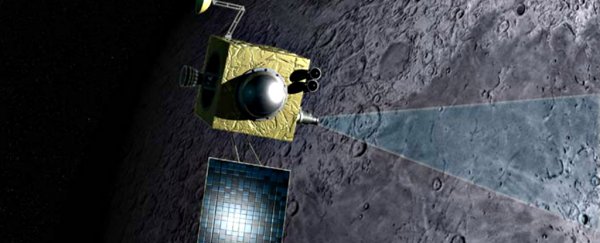An Indian spacecraft that lost contact with Earth eight years ago has been rediscovered orbiting the Moon.
NASA's Earth-based radars have detected the signal of the Indian Space Research Organisation's (ISRO) tiny Chandrayaan-1 spacecraft, which left Earth for the Moon's orbit back in 2008, and was last heard from in August 2009.
You'd think it wouldn't be that hard to find a spacecraft that we know is in orbit around our closest satellite, but it's a lot trickier than it sounds.
It's tough enough to accurately find space debris in Earth's own orbit, and thanks to the lunar glare, optical telescopes are out when it comes to looking for lost objects around the Moon.
Not to mention that Chandrayaan-1 is only around 1.5 metres (5 feet) on each side, so from Earth it would be less than a tiny speck around the Moon.
There's also the fact that our Moon is covered in regions called mascons, or mass concentrations, which have higher-than-average gravitational pull and have been known to tug a spacecraft out of orbit over time - sometimes even causing them to crash into the lunar surface.
So despite the fact that we last heard from Chandrayaan-1 while it was circling the Moon, after eight years of radio silence, there were no guarantees it was still there, and the orbiter had been classified as 'lost'.
But NASA has used a new radar technique to discover the missing spacecraft, as well as showing that it could accurately pinpoint the location of NASA's still-active Lunar Reconnaissance Orbiter (LRO).
"Finding LRO was relatively easy, as we were working with the mission's navigators and had precise orbit data where it was located," said Marina Brozovic, a radar scientist at NASA's Jet Propulsion Laboratory (JPL).
"Finding India's Chandrayaan-1 required a bit more detective work because the last contact with the spacecraft was in August of 2009."
To figure it out, the team first came up with the best predictions of where Chandrayaan-1 might have ended up. According to where it was last heard from, their best guess was that it would be some 200 km (124 miles) above the Moon, in a polar orbit.
Based on that estimate, they then beamed microwaves towards the Moon's north pole, around 380,000 km (237,000 miles) away, using a huge antenna at NASA's Goldstone Deep Space Communications Complex in California, and waited for them to bounce back.
The idea was that if any small spacecraft crossed the paths of these microwaves, they'd be able to detect them - similar to the way we can map the bottom of Earth's oceans with radars.
And that's exactly what happened - the team detected a small spacecraft crossing the path of the microwaves twice in around four hours, the same orbital period that Chandrayaan-1 was predicted to have.
They continued to listen in to the radars bouncing back from the spacecraft in order to get a better idea of its new orbit and position. Impressively, they found it had barely shifted course in the almost eight years it had been adrift by itself.
"It turns out that we needed to shift the location of Chandrayaan-1 by about 180 degrees, or half a cycle from the old orbital estimates from 2009," said Ryan Park, manager of JPL's Solar System Dynamics group.
"But otherwise, Chandrayaan-1's orbit still had the shape and alignment that we expected."
Chandrayaan-1 was India's first mission to the Moon, and its job was to perform chemical and geological mapping.
Most famously, it had an impactor attached to it that was released in November 2008 and deliberately crashed into the Moon, blasting up huge amounts of lunar dust for scientists to examine - providing the first solid evidence of water ice on the lunar surface.
After 10 months, Chandrayaan-1 completed its mission, and lost contact with Earth as planned.
No one knows what shape it's in now or what it's been doing out there in the cold depths of space all this time, but it's slightly comforting to know it's still there.
India is now planning its second moon mission, Chandrayaan-2, which will consist of an orbiter, lander, and rover, for early 2018.
In the case of Chandrayaan-1, there's not a whole lot we can do with this information. But the accurate discovery of the spacecraft, as well as NASA's LRO, is a proof-of-concept for this new technique, which will be hugely useful in years to come as we continue to send humans and technology out into space.
Not only does it mean we can keep better track of any spacecraft or people we have in space, but it also means we can better monitor for any hazards heading their way.
Plus, it's always nice to know in the cold expanse of space that someone back home can figure out where you are.
